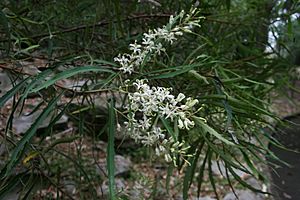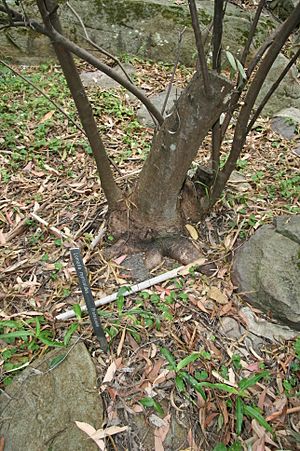Lomatia myricoides facts for kids
Quick facts for kids Lomatia myricoides |
|
|---|---|
 |
|
| Scientific classification | |
| Genus: |
Lomatia
|
| Species: |
myricoides
|
| Synonyms | |
|
Embothrium longifolium (R.Br.) Poir |
|
Lomatia myricoides is a plant often called the river lomatia. It grows as a shrub or small tree. You can find it in New South Wales and Victoria, which are states in southeastern Australia.
Contents
What Does It Look Like?
Lomatia myricoides is a woody shrub or a small tree. It usually grows to be about 2 to 5 meters (6.5 to 16 feet) tall. Sometimes, it can even reach up to 8 meters (26 feet) high.
Its leaves are long and narrow, like a spearhead or an oval. They can be from 5 to 20 cm (2 to 8 inches) long and 0.5 to 2 cm (0.2 to 0.8 inches) wide. The leaves have a pointed tip. They are smooth and shiny, without any hairs. Their edges can be straight or have small teeth.
The flowers grow in groups where the leaves meet the stem (called leaf axils). These flower groups are usually 5 to 10 cm (2 to 4 inches) long. They are often shorter than the leaves themselves. The flowers are typically white or cream in color. Sometimes, you might even see flowers with a hint of pink.
About Its Name
A German botanist named Karl Friedrich von Gaertner first described this plant in 1807. He called it Embothrium myricoides. Later, in 1921, Karel Domin gave it its current scientific name, Lomatia myricoides.
The name myricoides means 'like Myrica' in Latin. This is because its leaves look similar to plants in the Myrica genus. People also call this plant the river lomatia, mountain beech, or long-leaf lomatia.
Sometimes, Lomatia myricoides can mix with other Lomatia species. For example, it can form hybrids with tree lomatia (Lomatia fraseri) or crinkle bush (Lomatia silaifolia). Even though they can mix, each Lomatia species in southeastern Australia is unique enough to be considered its own type of plant.
Where It Lives
You can find Lomatia myricoides from the Central Coast of New South Wales all the way south into eastern Victoria. It grows as far as the Dandenong Ranges.
This plant likes moist, sheltered places. It often grows in forests along riverbanks or in mountain forests. It prefers soils that are loamy, sandy, or made from basalt rock.
Along watercourses, it often grows near other plants like watergum (Tristaniopsis laurina), grey myrtle (Backhousia myrtifolia), and cedar wattle (Acacia elata). In mountain areas, it can be found under taller trees like broad-leaved manna gum (Eucalyptus mannifera) and broad-leaved peppermint (E. dives).
Life Cycle and Survival
Lomatia myricoides has a special woody swelling at its base called a lignotuber. This helps the plant grow back after a bushfire. Small ants and flies visit the flowers to collect nectar.
Growing This Plant
You don't often see Lomatia myricoides in gardens. However, it can be grown in places that have some shade and stay moist. It seems to be strong against a plant disease called Phytophthora cinnamomi.
In the past, Joseph Maiden noted that the wood of this plant was light and hard. This made it easy to work with.



